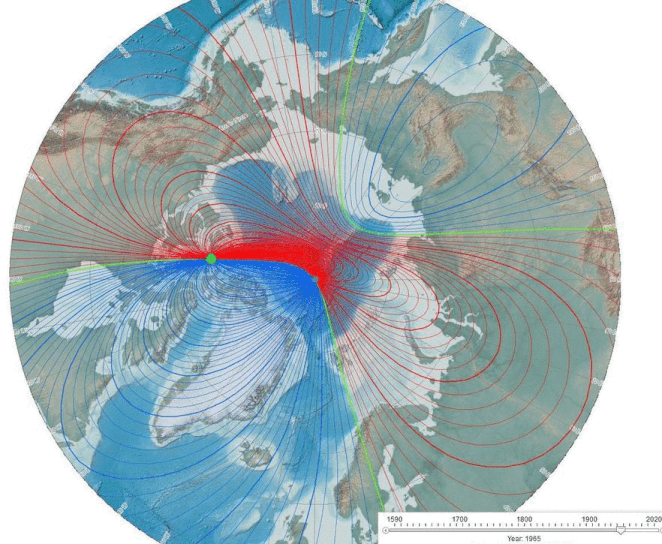Why You (Probably) Shouldn't Worry About Earth's Magnetic Poles Flipping

Earth's magnetic poles, whatever they're doing, are not going to spark chaos and kill us all — a scenario making the rounds online right now.
According to the Australian news site news.com.au, a magnetic flip would not only cause massive blackouts, "even flushing the toilet could become impossible."
As reported by Undark, Daniel Baker, the director of the Laboratory for Atmospheric and Space Physics at the University of Colorado, Boulder, is suggesting a reversal would render parts of the planet uninhabitable (though Baker is not directly quoted saying this).
Here's what's really happening and why there's no need to take cover in a doomsday bunker. [Doomsday: 9 Real Ways Earth Could End]
Oceans of molten iron are swirling deep inside the planet around the outer core. That sloshing sets up a giant bar magnet through Earth — though not a real concrete magnet, of course. This giant magnet sits at an angle of about 11 degrees from the axis around which Earth spins, according to Windows of the Universe. These poles are not in the same place as our geographic North and South poles.
And remember that swirling iron? It's constantly moving around. The result? Blobs of that iron get flipped in the opposite direction from iron atoms around them; scientists say they become "reverse-aligned." When there are enough reverse-aligned iron atoms, that giant bar magnet flips, and magnetic north becomes magnetic south.
But this bar magnet is no Olympic gymnast: The flipping isn't a quick turn but rather a gradual one, and can take between 1,000 and 10,000 years. "It's not a sudden flip, but a slow process, during which the field strength becomes weak, very probably the field becomes more complex and might show more than two poles for a while, and then builds up in strength and [aligns] in the opposite direction," Monika Korte, the scientific director of the Niemegk Geomagnetic Observatory at GFZ Potsdam in Germany, previously told Live Science.
Sign up for the Live Science daily newsletter now
Get the world’s most fascinating discoveries delivered straight to your inbox.
Magnetic north and south poles have swapped places hundreds of times in Earth's history, about every several hundred thousand years or so, scientists have found. The last one happened about 780,000 years ago. [7 Ways the Earth Changes in the Blink of an Eye]
In fact, there are signs of reversal right now. The magnetic field has been weakening at a faster clip, about 10 times faster than in the past, according to data from magnetometers on board the Swarm satellites (three satellites moving in tandem). This may or may not suggest the movement of the magnetic poles, scientists said.
"What currently has geophysicists like us abuzz is the realization that the strength of Earth's magnetic field has been decreasing for the last 160 years at an alarming rate," John Tarduno and Vincent Hare, of the University of Rochester, wrote in a The Conversation article last year.
"This collapse is centered in a huge expanse of the Southern Hemisphere, extending from Zimbabwe to Chile, known as the South Atlantic Anomaly. The magnetic field strength is so weak there that it's a hazard for satellites that orbit above the region — the field no longer protects them from radiation which interferes with satellite electronics."
If the poles really did do a switcheroo, Earthlings would notice, though scientists aren't worried about a planetwide doomsday.
Just before a reversal, the extreme weakening of our magnetic field, the shield that protects us from charged particles constantly blasting the atmosphere, could cause trouble. Live Science previously reported these charged solar particles could punch holes in Earth's atmosphere akin to the ozone hole above Antarctica. Whether those holes would have any true impact is debatable, scientists have said.
The increased radiation, however, could mess with the navigation of satellites and aircraft as well as electrical power grids. "Were this to happen today, the increase in charged particles reaching the Earth would result in increased risks for satellites, aviation and ground-based electrical infrastructure," University of Leeds geophysicists Phil Livermore and Jon Mound wrote in an article for The Conversation.
And those alleged links between magnetic pole reversals and lights out for Earth and all its creatures … well, those are more fantasy than in real life.
Original article on Live Science.
Jeanna Bryner is managing editor of Scientific American. Previously she was editor in chief of Live Science and, prior to that, an editor at Scholastic's Science World magazine. Bryner has an English degree from Salisbury University, a master's degree in biogeochemistry and environmental sciences from the University of Maryland and a graduate science journalism degree from New York University. She has worked as a biologist in Florida, where she monitored wetlands and did field surveys for endangered species, including the gorgeous Florida Scrub Jay. She also received an ocean sciences journalism fellowship from the Woods Hole Oceanographic Institution. She is a firm believer that science is for everyone and that just about everything can be viewed through the lens of science.










